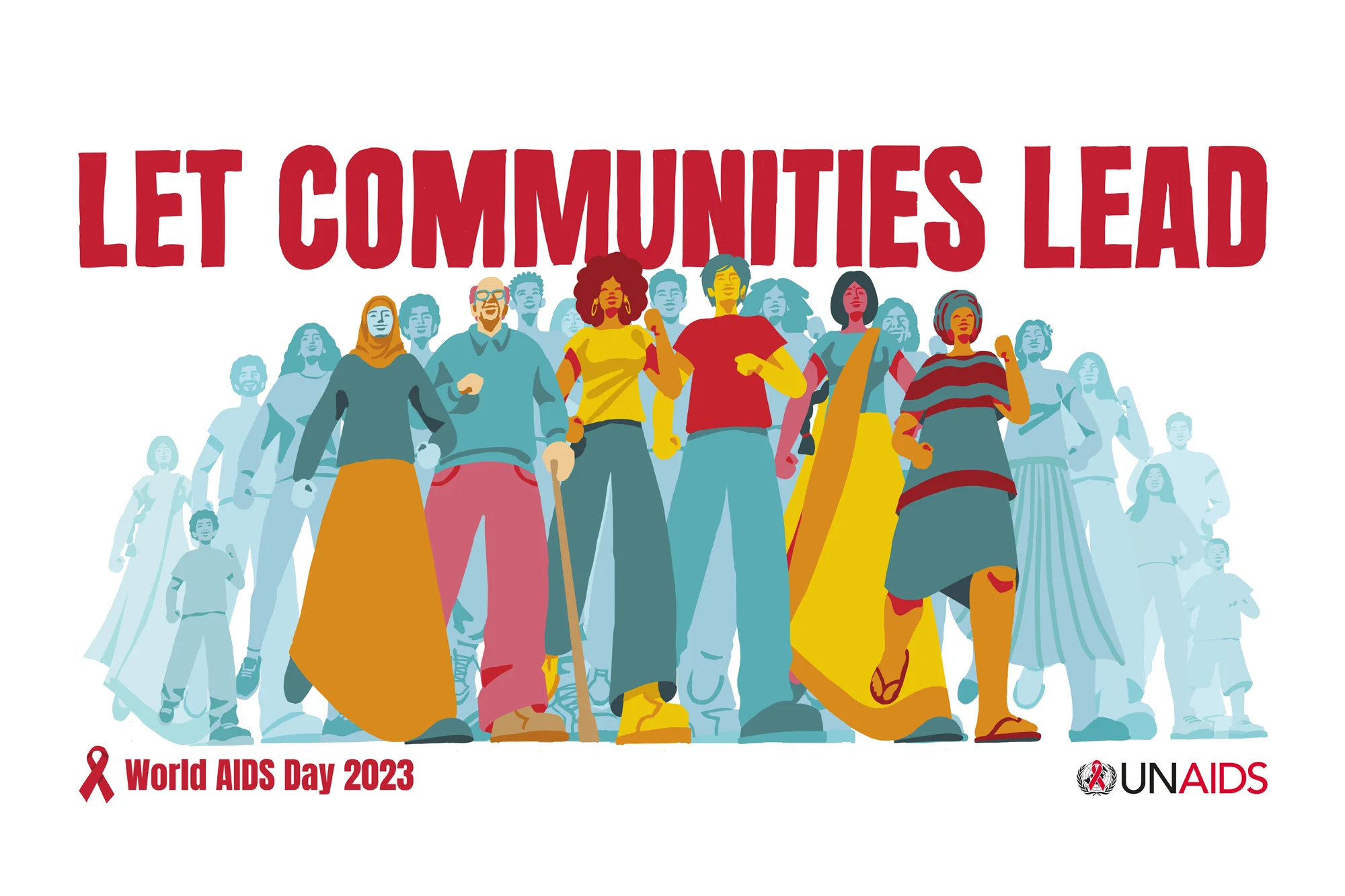World AIDS Day 2023
The World AIDS Day is observed annually on December 1st to raise awareness about the Acquired Immunodeficiency Syndrome (AIDS) caused by the Human Immunodeficiency Virus (HIV), to commemorate those who have died from HIV/AIDS, and to reaffirm the commitment to working towards an HIV-free world.
World AIDS Day 2023 Theme

The World AIDS Day 2023 focuses on the theme “LET COMMUNITIES LEAD.”
Organizations of communities affected by HIV play a crucial role in the progress of the HIV response. They connect people with personalized public health services, build trust, innovate, monitor policy and service implementation, and hold providers accountable.
LET COMMUNITIES LEAD
However, these community-led efforts face challenges, including funding shortages, policy hurdles, capacity constraints, and crackdowns on civil society and human rights. Overcoming these obstacles is vital for advancing HIV prevention and treatment services. World AIDS Day 2023 emphasizes the need to recognize and support community leadership. Key points include:
- Integration of Community Leadership: Community leadership should be a core element in all HIV plans and programs, influencing formulation, budgeting, implementation, and evaluation.
- Sustainable Funding: Adequate and reliable funding is essential to scale up community-led efforts, and support and remuneration for these roles should be ensured.
- Removing Barriers: Regulatory environments should enable communities to play a role in providing HIV services, ensure civil society space, and protect human rights, particularly for marginalized communities.
This World AIDS Day calls for collective action to unleash the full potential of community leadership and move closer to ending AIDS globally.
What is AIDS
What is HIV-AIDS? HIV and AIDS are terms often used interchangeably, but they have distinct meanings. The HIV stands for Human Immunodeficiency Virus, while AIDS stands for Acquired Immunodeficiency Syndrome.
HIV
HIV is a virus that attacks the body’s immune system, the body’s defense against infections and diseases. When HIV enters the body, it targets and destroys CD4 cells, a type of white blood cell that plays a critical role in the immune system. As HIV replicates within the body, it gradually weakens the immune system. It makes the infected person more susceptible to infections and diseases that would normally be easily fought off.
AIDS
AIDS is the most advanced stage of HIV infection. It occurs when the immune system has been severely damaged by HIV. It leaves the body vulnerable to opportunistic infections, which are infections caused by organisms that typically don’t pose a threat to people with healthy immune systems. These opportunistic infections can lead to serious illnesses and eventually death.
Transmission of HIV
HIV is primarily transmitted through the exchange of bodily fluids, including:
- Blood-to-blood contact: Sharing needles or syringes, receiving blood transfusions from an infected person, or having direct contact with open wounds of an infected person.
- Sexual contact: Unprotected vaginal, anal, or oral sex with an infected person.
- Mother-to-child transmission: During pregnancy, childbirth, or breastfeeding, an infected mother can transmit HIV to her child.
Preventing HIV
There is no cure for HIV, but there are effective ways to prevent its transmission:
- Abstinence: Choosing not to have sexual intercourse is the most effective way to prevent HIV transmission through sexual contact.
- Consistent use of condoms: Using condoms correctly and consistently during every act of vaginal, anal, or oral sex significantly reduces the risk of HIV transmission.
- Pre-exposure prophylaxis (PrEP): PrEP is a daily medication that can help prevent HIV infection in people who are at high risk of contracting the virus.
- Post-exposure prophylaxis (PEP): PEP is a medication that can help prevent HIV infection in people who have been exposed to the virus, such as through unprotected sex or needle sharing, if taken within 72 hours of exposure.
- Safe injection practices: Never share needles or syringes, and use only sterile equipment for injecting drugs or medications.
- Testing and treatment: Early diagnosis and treatment of HIV can help prevent the progression to AIDS and reduce the risk of transmitting the virus to others.
Living with HIV
With proper medical care and treatment, people with HIV can live long and healthy lives. Antiretroviral therapy (ART) is a combination of medications that can suppress HIV replication. It allows the immune system to recover and reduce the risk of opportunistic infections and progression to AIDS.
HIV and AIDS remain significant global health challenges. But significant progress has been made in understanding, preventing, and treating the disease. With continued research, education, and prevention efforts, we can work towards a world free from HIV and AIDS.
History of World AIDS Day
World AIDS Day is observed globally on December 1st each year. It is a widely recognized international health day, providing a significant opportunity to raise awareness, honor those who have passed away, and celebrate achievements such as increased access to treatment and prevention services.
UNAIDS initially led the campaign for World AIDS Day until 2004. Subsequently, the World AIDS Campaign’s Global Steering Committee began selecting themes for World AIDS Day in collaboration with civil society, organizations, and government agencies involved in the AIDS response. These themes typically run for one or two years and are not limited to World AIDS Day, often serving as year-round campaigning slogans, such as ‘Stop AIDS. Keep the Promise,’ to hold governments accountable for their commitments related to HIV and AIDS.
Global HIV statistics
- 39 million [33.1 million–45.7 million] people globally were living with HIV in 2022.
- 1.3 million [1 million–1.7 million] people became newly infected with HIV in 2022.
- 630 000 [480 000–880 000] people died from AIDS-related illnesses in 2022.
- 29.8 million people were accessing antiretroviral therapy in 2022.
- 85.6 million [64.8 million–113.0 million] people have become infected with HIV and 40.4 million [32.9 million–51.3 million] people have died from AIDS-related illnesses since the start of the epidemic.
People living with HIV
- In 2022, there were 39 million [33.1 million–45.7 million] people living with HIV.
- 37.5 million [31.8 million–43.6 million] adults (15 years or older).
- 1.5 million [1.2 million–2.1 million] children (0–14 years).
- 53% of all people living with HIV were women and girls.
- 86% [73– >98%] of all people living with HIV knew their HIV status in 2022.
In 2022, there was an estimated 90% funding gap for HIV prevention programmes among people from key populations, compared with the funding needed by 2025.
Significance of World AIDS Day
World AIDS Day, observed annually on December 1st, holds immense significance in the global fight against HIV/AIDS. It serves as a crucial reminder of the ongoing epidemic, commemorates those who have lost their lives to the disease, and reaffirms the commitment to working towards an HIV-free world.
Raising Awareness and Combating Stigma
World AIDS Day plays a pivotal role in raising global awareness about HIV/AIDS, its transmission, prevention, and treatment. It challenges the stigma and discrimination often associated with the disease, promoting understanding, acceptance, and compassion towards those affected.
Progress and Challenges
The day serves as a platform to celebrate the remarkable progress made in the fight against HIV/AIDS. The development of antiretroviral therapy (ART) has transformed HIV/AIDS from a fatal disease into a manageable chronic condition, saving millions of lives and improving the quality of life for countless others.
However, significant challenges remain in the ongoing battle against HIV/AIDS. Access to treatment and care remains a major issue, particularly in developing regions. New HIV infections continue to occur, disproportionately affecting marginalized communities. Stigma and discrimination continue to hinder prevention efforts and discourage individuals from seeking testing and treatment.
Collective Action for an HIV-Free World
World AIDS Day emphasizes the collective responsibility and shared commitment required to achieve an HIV-free world. It calls for concerted efforts from governments, healthcare providers, civil society organizations, and individuals to address the challenges and ensure equitable access to prevention, treatment, and care for all.
Actions to Take
Everyone can make a difference in the fight against HIV/AIDS. Here are some ways to contribute:
- Educate Yourself: Gain knowledge about HIV/AIDS, its transmission, prevention, and treatment.
- Get Tested: Knowing your HIV status is crucial for seeking appropriate care and preventing further transmission.
- Spread Awareness: Talk openly about HIV/AIDS with friends, family, and community members to dispel myths and promote understanding.
- Support Organizations: Donate time or resources to organizations dedicated to HIV/AIDS prevention, treatment, and research.
World AIDS Day serves as a powerful reminder that together, we can overcome the challenges of HIV/AIDS and create a healthier, more equitable world for all.
- SSC CGL Full Form, All You Need to Know About SSC CGL
- SBI CBO Admit Card 2025 Out, Exam Date 20th July
- SSC CHSL 2025 Vacancies Released for 3131 Posts, Complete Details
- SSC JE Vacancies 2025, Check Post Wise Vacancy List
- Important Percentage Questions for SSC Exam Preparation, Solved
- SSC CGL Application Correction Form Starts from 9th to 11th July

Hello, I’m Aditi, the creative mind behind the words at Oliveboard. As a content writer specializing in state-level exams, my mission is to unravel the complexities of exam information, ensuring aspiring candidates find clarity and confidence. Having walked the path of an aspirant myself, I bring a unique perspective to my work, crafting accessible content on Exam Notifications, Admit Cards, and Results.
At Oliveboard, I play a crucial role in empowering candidates throughout their exam journey. My dedication lies in making the seemingly daunting process not only understandable but also rewarding. Join me as I break down barriers in exam preparation, providing timely insights and valuable resources. Let’s navigate the path to success together, one well-informed step at a time.






